
photographs by David Luttrell
Renovation of the graceful, historic Gay Street Bridge passed the halfway point last month. The $16 million federal/local project will restore the bridge, as closely as possible, to its original 1898 condition. Only minimal modifications will be made to satisfy modern safety requirements.
Ann Bennett of the Metropolitan Planning Commission says the bridge's design was the first of its kind and that the bridge is the last of its kind standing in the United States. Its uniqueness influenced the federal government to finance 80 percent of its restoration.
It is a steel cantilevered bridge set on stone piers (A). While many steel bridges have their 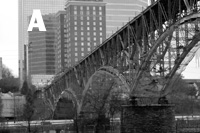 roadway laid along the bottom of the super- structure, the Gay Street Bridge's structure supports the deck from beneath it. roadway laid along the bottom of the super- structure, the Gay Street Bridge's structure supports the deck from beneath it.
The state Department of Transportation is administering the contract, with Ray Bell Construction Co., the general contractor. Jeff Walker, with the construction company, says corroded pieces are being replaced. Most of the replacement effort centers on pin joints (B) being fabricated at Beverly Steel's North Knoxville shop. Those joints lend the bridge structure the flexibility needed to expand, contract, and sway.
To bolt the pin joints in place, the old joints are cut away and replaced temporarily by erector-set-like jacking frames (E). At the height of the pin-joint replacement process, Beverly Steel had 20 to 30 ironworkers on the job (C&D). The workers can negotiate the span easily by walking along on taught steel mesh netting strung under the bridgework (F).
Walker says the entire restoration effort will involve replacement of about two million pounds of steel, mostly in pieces weighing 200 pounds or less.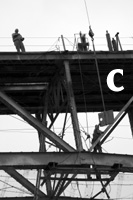
The challenge is working with hundred-year-old engineering that was state-of-the-art at that time, Walker says. Danny Wright of Beverly Steel says the project has been fun to work with. "The steel framework is in really good shape. It's amazing to think they erected this without trucks, with horses and wagons.
"The stonework [in the piers] is unreal," Wright says. Walker says the bearing platforms between the bridge structure and the piers were also in remarkably good condition, needing only replacement of some deteriorating concrete.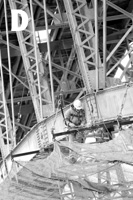
The bridge's deck was stripped of its two layers of asphalt and one of concrete. Walker says the new bridge floor will weigh 20 percent less than the layered melange his company is replacing, so that the weight limit of 5 tons that was enforced in the last several years theoretically could be raised to allow for heavier vehicles.
In the old roadway, trolley rails were found embedded. Bennett says the trolley company that got the easement also developed the Island Home neighborhood of South Knoxville, which was previously so isolated it was referred to routinely as "South America."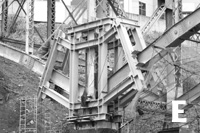
Ferry service preceded the first bridge across the Tennessee River. It was a pontoon affair left by the Union Army in 1865 that washed away in a flood less than two years later, and an 1871 bridge structure was blown down in an 1875 tornado. An 1880 bridge was replaced by the present bridge. 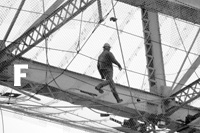 Little wonder that development south of the river was a spotty endeavor until the 20th century. The "modern" steel bridge is depicted in the early 1900s in postcard images (right). Little wonder that development south of the river was a spotty endeavor until the 20th century. The "modern" steel bridge is depicted in the early 1900s in postcard images (right).
Fixed up to 2000 standards, Walker says, "This bridge should last a long time." It's on schedule for reopening this December.

February 6, 2003 * Vol. 13, No. 6
© 2003 Metro Pulse
|